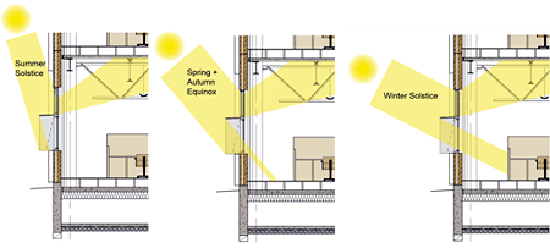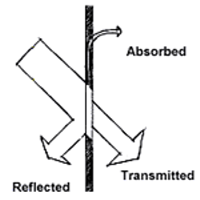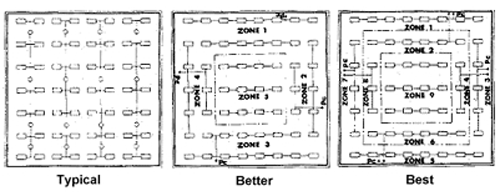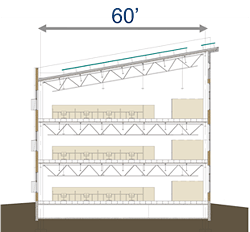Introduction
Within This Page
Daylighting is the controlled admission of natural light, direct sunlight, and diffused-skylight into a building to reduce electric lighting and saving energy. By providing a direct link to the dynamic and perpetually evolving patterns of outdoor illumination, daylighting helps create a visually stimulating and productive environment for building occupants, while reducing as much as one-third of total building energy costs.
A daylighting system is comprised not just of daylight apertures, such as skylights and windows, but is coupled with a daylight-responsive lighting control system. When there is adequate ambient lighting provided from daylight alone, this system has the capability to reduce electric lighting power. Further, the fenestration, or location of windows in a building, must be designed in such a way as to avoid the admittance of direct sun on task surfaces or into occupants' eyes. Alternatively, suitable glare remediation devices such as blinds or shades must be made available.
Implementing daylighting on a project goes beyond simply listing the components to be gathered and installed. Daylighting requires an integrated design approach to be successful, because it can involve decisions about the building form, siting, climate, building components (such as windows and skylights), lighting controls, and lighting design criteria.
This overview is intended to provide specific details for Federal agencies considering daylighting technologies as part of a new construction project or major renovation.
Description
The science of daylighting design is not just how to provide enough daylight to an occupied space, but how to do so without any undesirable side effects. Beyond adding windows or skylights to a space, it involves carefully balancing heat gain and loss, glare control, and variations in daylight availability. For example, successful daylighting designs will carefully consider the use of shading devices to reduce glare and excess contrast in the workspace. Additionally, window size and spacing, glass selection, the reflectance of interior finishes, and the location of any interior partitions must all be evaluated.
A daylighting system consists of systems, technologies, and architecture. While not all of these components are required for every daylighting system or design, one or more of the following are typically present:
- Daylight-optimized building footprint
- Climate-responsive window-to-wall area ratio
- High-performance glazing
- Daylighting-optimized fenestration design
- Skylights (passive or active)
- Tubular daylight devices
- Daylight redirection devices
- Solar shading devices
- Daylight-responsive electric lighting controls
- Daylight-optimized interior design (such as furniture design, space planning, and room surface finishes).
Since daylighting components are normally integrated with the original building design, it may not be possible to consider them for a retrofit project.
If possible, the building footprint should be optimized for daylighting. This is only possible for new construction projects and does not apply to retrofits. If the project allows, consider a building footprint that maximizes south and north exposures, and minimizes east and west exposures. A floor depth of no more than 60 ft., 0 in. from south to north has been shown to be viable for daylighting. A maximum facade facing due south is the optimal orientation. Deviation from due south should not exceed 15° in either direction for best solar access and ease of control.
With the building sited properly, the next consideration is to develop a climate-responsive window-to-wall area ratio. As even high-performance glazings do not have insulation ratings close to those of wall constructions, the window area needs to be a careful balance between admission of daylight and thermal issues such as wintertime heat loss and summertime heat gain. The American Society of Heating, Refrigerating, and Air Conditioning Engineers (ASHRAE) offers guidance on these ratios per climate zone in their Standard 90.1 energy code, but these are primarily minimal for thermal performance and do not consider admission of daylight.
A high-performance glazing system will generally admit more light and less heat than a typical window, allowing for daylighting without negatively impacting the building cooling load in the summer. This is typically achieved through spectrally-selective films. These glazings are typically configured as a double pane insulated glazing unit, with two 0.25 in. (6 mm) thick panes of glass that are separated by a 0.50 in. (12 mm) air gap. This construction gives the insulated glazing unit a relatively high insulation rating, or R-value, as compared to single pane glass. A low-emissivity coating is also often part of these high-performance glazing units, which further improves the R-value of the unit.
In addition to the considerations above regarding windows, a daylighting-optimized fenestration design will increase system performance. The window has two essential functions in a daylit building: (1) daylight delivery or admittance, and (2) provision of view to the occupants. The former dictates a glazing with a very high visible light transmittance (commonly abbreviated as VLT, or Tvis), the latter merely needs to be clear, and, in fact, should have a relatively low Tvis to prevent glare. As a general rule, the higher the window head height, the deeper into the space the daylight can penetrate. Therefore, good daylighting fenestration practice dictates that the window should ideally be composed of two discrete components: a daylight window and a view window. The daylight window should start at 7 ft., 6 in. above the finished floor at a minimum and have a high Tvis (50% to 75%); the view window should be placed lower and have a Tvis of less than 40% in most climates.
Many daylighting designs will employ skylights for toplighting, or admitting daylight from above. While skylights can be either passive or active, the majority of skylights are passive because they have a clear or diffusing medium (usually acrylic) that simply allows daylight to penetrate an opening in the roof. They are often comprised of a double layer of material, for increased insulation. Active skylights, by contrast, have a mirror system within the skylight that tracks the sun and are designed to increase the performance of the skylight by channeling the sunlight down into the skylight well. Some of these systems also attempt to reduce the daylight ingress in the summer months, balancing daylighting with cooling loads.
Tubular daylight devices are another type of toplighting device. These devices employ a highly reflective film on the interior of a tube to channel light from a lens at the roof, to a lens at the ceiling plane. Tubular daylight devices tend to be much smaller than a typical skylight, yet still deliver sufficient daylight for the purpose of dimming the electric lighting.
Daylight redirection devices take incoming direct beam sunlight and redirect it, generally onto the ceiling of a space. These devices serve two functions: glare control, where direct sun is redirected away from the eyes of occupants, and daylight penetration, where sunlight is distributed deeper into a space that would not be allowed otherwise. Daylight redirection devices generally take one of two forms: a large horizontal element, or louvered systems. Horizontal daylight redirection devices are often called lightshelves.
As mentioned previously, the windows must be carefully designed to control the solar gains and potential glare stemming from a daylighting design. To this end, solar shading devices are often employed-particularly on the view windows-to minimize the amount of direct sun that enters the space. These are typically called overhangs.
Daylight-responsive electric lighting controls are absolutely essential to any daylighting system. No daylighting design will save any energy unless the electric lights are dimmed or turned off when there is sufficient illumination from daylight. Indeed, if daylighting features such as windows and skylights are not paired with daylighting functionality such as daylight-responsive dimming controls, then the daylighting-enhanced building will more than likely use more energy, not less, than a comparable building without any daylighting features. Daylight-responsive lighting controls consist of continuous dimming- or stepped-ballasts in the light fixtures, and one or more photocells to sense the available light and dim or turn off the electric lighting in response.
An often overlooked element in a successful daylighting design is the interior design. A daylight-optimized interior design considers furniture design, placement, and room surface finishes with respect to daylight performance. For example, office cubicle partition heights will be limited, particularly those running parallel to the south facade, enclosed offices will be kept to a minimum, and walls and ceilings will be as highly reflective as possible, to help "bounce" and distribute the redirected daylight more fully. By positioning work surfaces at a distance from the south facade, solar control is easier with smaller solar shading devices than if a desk or office is placed directly against the south facade. This concept is illustrated in the following figure, and shows how a relatively small overhang provides full direct seasonal solar protection to the workspace. The area immediately adjacent to the south facade is circulation space.

Seasonal performance of shading, redirection devices. Illustration by RNL Design
Types of Technology
Daylighting is an energy-efficient strategy that incorporates many technologies and design philosophies. It is not a simple line item, and can vary tremendously in scope and cost. Many elements of a daylighting implementation will likely already be part of a building design or retrofit (e.g. windows and light fixtures), but a successful daylighting system will make use of the following technology types and construction methods:
Exterior shading and control devices. In hot climates, exterior shading devices often work well to both reduce head gain and diffuse natural light before entering the work space. Examples of such devices include light shelves, overhangs, horizontal louvers, vertical louvers, and dynamic tracking of reflecting systems.

Glazing materials. The simplest method to maximize daylight within a space is to increase the glazing area. However, three glass characteristics need to be understood in order to optimize a fenestration system:
- U-value: represents the rate of heat transfer due to temperature difference through a particular glazing material.
- Shading coefficient: a ratio of solar heat gain of a given glazing assembly compared to double-strength, single glazing. (A related term, solar heat gain coefficient, is beginning to replace the term shading coefficient.)
- Visible transmittance: a measure of how much visible light is transmitted through a given glazing material.
Aperture location. Simple sidelighting strategies allow daylight to enter a space and can also serve to facilitate views and ventilation. Typically, the depth of daylight penetration is about two and one-half times the distance between the top of a window and the sill.
Reflectances of room surfaces. Reflectance values from room surfaces will significantly impact daylight performance and should be kept as high as possible. It is desirable to keep ceiling reflectances over 80%, walls over 50%, and floors around 20%. Of the various room surfaces, floor reflectance has the least impact on daylighting penetration.
Integration with electric lighting controls. A successful daylighting design not only optimizes architectural features, but is also integrated with the electric lighting system. With advanced lighting controls, it is now possible to adjust the level of electric light when sufficient daylight is available. Three types of controls are commercially available:
- Switching controls: on-and-off controls that simply turn the electric lights off when there is ample daylight.
- Stepped controls: control individual lamps within a luminary to provide intermediate levels of electric lighting.
- Dimming controls: continuously adjust electric lighting by modulating the power input to lamps to complement the illumination level provided by daylight.

Control Scheme Types
- Other lighting control schemes. In addition to daylight controls, other electric lighting control strategies should be incorporated where they are cost effective, including the use of:
- Occupancy controls: using infrared, ultrasonic, or micro-wave technology, occupancy sensors respond to movement or object surface temperature and automatically turn off or dim down luminaries when rooms are left unoccupied. Typical savings have been reported to be in the 10% to 50% range depending on the application.
- Timers: these devices are simply time clocks that are scheduled to turn lamps or lighting off on a set schedule. If spaces are known to be unoccupied during certain periods of time, timers are extremely cost-effective devices.
Application
Daylighting can be a viable, energy-efficient strategy in almost any climate, including traditionally overcast climates such as those found in parts of the Pacific Northwest. The technology can work in all building types as well, including commercial office buildings, most spaces within a school (i.e. classrooms, gymnasiums, media centers, cafeterias, and offices), retail stores, hospitals, libraries, warehouses, and maintenance facilities. A viable option for most building types and locations, it is important to consider that the architectural response to daylighting differs by building type, climate, and glare tolerability.
Economics
Daylighting has the potential to provide significant cost savings. For example, using an estimated incremental first cost increase of $0.50 to $0.75 per square foot of occupied space for dimmable ballasts, fixtures, and controls, daylighting has been shown to save from $0.05 to $0.20 per square foot annually (1997).
Additionally, electric lighting accounts for 35% to 50% of the total electrical energy consumption in commercial buildings. By generating waste heat, lighting also adds to the loads imposed on a building's mechanical cooling equipment. The energy savings from reduced electric lighting through the use of daylighting strategies can directly reduce building cooling energy usage by an additional 10% to 20%. Consequently, for many institutional and commercial buildings, total energy costs can be reduced by as much as one-third through the optimal integration of daylighting strategies.
In addition, the benefits of a daylit building extend beyond simple energy savings. For example, by reducing the need for electric consumption for lighting and cooling, the use of daylight reduces greenhouse gases and slows fossil fuel depletion. Numerous studies also indicate that daylighting can help increase worker productivity and decrease absenteeism in daylit commercial office buildings, boost test scores in daylit classrooms, and accelerate recovery and shorten stays in daylit hospital patient rooms.
As with all energy-efficient design strategies, there are some costs associated with the use of daylighting. Designers must be sure to avoid glare and overheating when placing windows. More windows do not automatically result in more daylighting. That is, natural light has to be controlled and distributed properly throughout the workspace. Also, for cost savings to be realized, controls have to be in proper functioning order. Poor installation, commissioning, or operation and maintenance (O&M) practices can all lead to less-than-favorable performance.
The efficacy of daylighting in terms of saving energy (or money) is measured not only with economic or photometric methods, but also by psychological and aesthetic benefits that translate into financial benefits. For more information, see the Additional Resources section.
Assessing Resource Availability
Architectural daylighting is not solely dependent on sunlight quantity or on the number of sunny days per year; it can also take advantage of diffuse skylight (predominantly found in overcast climates). As such, direct solar resource is not the sole determinant for daylighting feasibility.
Since the efficacy of a daylighting design is tightly tied to the building design, the best way to assess a daylighting project is to perform a daylighting analysis through simulation. Lighting simulation software is available and can be used to simulate the performance of a building in a given climate and to predict illuminance levels from daylight, determine dimming and switching response from available daylight, estimate the annual energy savings from daylighting functionality, and even predict the glare probability for a given design.
Design Considerations

Optimal daylit building section. Illustration by RNL Design
The components of a daylighting system are designed to bring natural light into a building in such a way that electric lights can be dimmed or turned off for a portion of the day, while preventing occupant discomfort or other building loads from increasing. For example, direct sun in the eye of a building occupant can cause disability glare, which interferes with the occupant's ability to see and perform work and should be avoided. Depending on the building construction and prevailing climate, excessive window area could also increase the cooling load in summer or accelerate heat loss in winter.
An optimized building footprint is a foundational element of a daylit building design. Maximizing the amount of south- and north-facing facade area and minimizing east and especially west exposure allows for the easiest controllable daylight fenestration. Restricting the floor plate depth (north-to-south) also helps to daylight as much floor area as possible, as there are practical limitations to how far one can transmit daylight in sidelighting applications.
As daylight penetration is limited by the siting and facade design, the circuiting of the electric light fixtures is critical in gauging success of a daylighting strategy. Ideally, the light fixtures should be circuited in groups, or zones, that relate to the predominant daylight distribution in the space. In general, the first 10 to 15 feet from the building perimeter receives adequate daylight illumination to allow for light dimming or switching. By zoning the lighting accordingly, there's a greater chance of ensuring maximum dimming of the lights.
Additionally, it is important for the daylighting design process to involve the integration of many disciplines including mechanical, electrical, and lighting. Design team members need to be brought into the process early to ensure that daylighting concepts and ideas are carried throughout the project.
Awareness of basic visual acuity and performance issues is essential to an effective daylighting design, including:
Veiling reflections. Veiling reflections of high brightness light sources off specular, or shiny, surfaces obscure details by reducing contrast. They should be avoided, particularly where critical visual tasks occur.
Distribution.Introduce as much controlled daylight as deep as possible into a building interior. The human eye can adjust to high levels of luminance as long as it is evenly distributed. In general, light which reaches a task indirectly (such as having bounced from a white wall) will provide better lighting quality than light which arrives directly from a natural or artificial source.
Glare. The aim of an efficient daylighting design is not only to provide illuminance levels that are sufficient for good performance, but also to maintain a comfortable and pleasing atmosphere. Glare, or excessive brightness contrast within the field of view, is an aspect of lighting that can cause discomfort to occupants. The human eye can function quite well if extreme levels of brightness are present in the same field of view.
Variety. Some contrast in brightness levels may be desirable in a space for visual effectiveness. Dull uniformity in lighting can lead to tiredness and lack of attention-neither of which is compatible with a productive environment. Often, a good daylighting solution will integrate a "blast" of beam daylight in a circulation area for visual interest and to help lead occupants through a building. The human eye is naturally attracted to this bright area and can be useful in guiding people down an otherwise dull corridor.
Good daylighting requires attention to both qualitative and quantitative aspects of design. Make sure the combination of natural and artificial sources provides adequate light levels for the required task.
The Illuminating Engineering Society (IES) publishes an industry standard method for determining recommended illuminance levels (expressed in units of footcandles) for various tasks.
For office spaces, the U.S. General Services Administration has interpreted the IES method to recommend a minimum of 50 footcandles on an imaginary desk-height horizontal "work surface." Nevertheless, when used in conjunction with an indirect ambient lighting system and direct task lighting, a high-quality daylighting design can be achieved with ambient lighting levels of 30 footcandles or less.
To be effective, daylighting must be integrated with electric lighting design. In particular, daylighting must be coupled with efficient electric lighting controls if net energy savings are to be realized. As part of a daylighting design, consider the use of continuously dimming fixtures controlled by luminous sensors.
Design Recommendations
During the design process, the following design strategies should be understood and explored:
Increase perimeter daylight zones-extend the perimeter footprint to maximize the usable daylighting area.
Allow daylight penetration high in a space. Windows located high in a wall or in roof monitors and clerestories will result in deeper light penetration and reduce the likelihood of excessive brightness.
Reflect daylight within a space to increase room brightness. A light shelf, if properly designed, has the potential to increase room brightness and decrease window brightness.
Slope ceilings to direct more light into a space. Sloping the ceiling away from the fenestration area will help increase the surface brightness of the ceiling further into a space.
Avoid direct beam daylight on critical visual tasks. Poor visibility and discomfort will result if excessive brightness differences occur in the vicinity of critical visual tasks.
Filter daylight. The harshness of direct light can be filtered with vegetation, curtains, louvers, or the like, and will help distribute light.
Understand that different building orientations will benefit from different daylighting strategies; for example, light shelves-which are effective on south facades-are often ineffective on east or west elevations of buildings.
Physical Modeling
The physics of illumination are such that light behaves exactly the same way in a scaled model as it does in a full-size room. Physical models can be built inexpensively and at various stages of the design process. A number of issues can be accomplished with physical models:
- Photographs of the model interior can be taken to record and study various design alternatives
- The effect of different glass areas and locations can be studied
- The use of photometers. Illumination levels resulting from different daylighting schemes can be compiled and used to project energy savings.
Operation and Maintenance
Daylighting designs generally employ static elements and do not require significant O&M beyond the normal building envelope care.
Commissioning
The most common reason for a daylighting design to fail is lack of proper commissioning. The lighting controls must be commissioned (i.e. the building control system must have the lighting set points properly configured) if the system is to properly respond to available daylight. Far too often, the commissioning of the lighting controls is inadequately performed, leading to one of two outcomes: either the lights do not dim when they should, resulting in increased energy use, or the lights dim when they shouldn't, resulting in complaints from occupants. When this occurs, the building operator must disable the dimming system, again leading to increased energy use. The success of a daylighting design depends completely on commissioning and continued evaluation of the daylight system.
Ongoing Maintenance
During regular building operation, maintenance needs to periodically check the functionality of the daylight-responsive electric lighting controls, as noted above, to ensure that the system is saving energy as planned and has not been overridden.
As part of any routine building cleaning regimen, any daylight redirection devices should be cleaned on a regular basis to ensure the optimal performance of the reflecting surfaces. For commercial office spaces, most manufacturers of these kinds of devices recommend an annual cleaning cycle, with more frequent cleanings required for dirtier environments.
Maintenance also should ensure that areas designed to admit daylight are not shaded by growth of landscaping or other obstructions. Initial landscape design should account for daylighting needs as landscape matures. However, if maturing landscape interferes with daylight levels, significant pruning or replanting may be needed to ensure that daylight levels are maintained as designed.
Special Considerations
Since a daylighting system operates differently than a system used in a conventional building, occupants should be trained on the operation of the switches (if any are provided), on the overall design intent, and on the expected functionality of the daylighting system. In a conventional building, lights are typically on all the time whether they are needed or not. Therefore, if users are better informed about the building's design and operational goals, they will likely make a greater effort to operate the building properly, and to communicate when the lighting does not work as expected (and willing to inform the ongoing commissioning process, as discussed above).
The lighting expectations and glare tolerance of building occupants can vary greatly. If possible, provide flexibility in the furniture system and programming to allow for variability in occupant tolerance and illumination requirements. Additionally, a typical daylighting design will provide a variety of illuminance and contrast throughout the space due to the dynamic nature of daylight. Allowing for flexibility in where people sit and which direction they face goes a long way toward increasing occupant acceptance of the daylighting system.
Relevant Codes and Standards
There are various local and national codes and standards for distributed electric generator integration and interconnection with the utilities. The following list identifies the existing codes and standards applicable to daylighting.
- ASHRAE 90.1 Energy Standard for Buildings Except Low-Rise Residential Buildings
- ASHRAE 189.1 Standard for the Design of High-Performance Green Buildings Except Low-Rise Residential Buildings
- Energy Policy Act of 2005 (Federal mandate)
- U.S. Green Building Council Leadership in Energy and Environmental Design (LEED) Building Rating System(s)
- Unified Facilities Criteria 3-530-01 Interior and Exterior Lighting Systems and Controls
- NREL Energy Technology Cost and Performance Data compares cost estimates for renewable energy and other technologies on a national level.
Additional Resources
Associations and Organizations
- Daylight Dividends is a multi-year joint research program of the DOE and a variety of state energy agencies facilitating the widespread implementation of daylight in buildings.
- ENERGY STAR, first established in 1991 as a voluntary labeling program, helps both businesses and consumers reduce costs and protect the environment through energy efficient products and practices.
- International Commission on Illumination (CIE) The United States National Committee CIE/(USA) is a not-for-profit organization formed in 1913 to assist the International Commission on Illumination in achieving its objectives in the fields of light and lighting.
- Illuminating Engineering Society (IES) is an organization whose mission is to advance knowledge and disseminate information for the improvement of the lighted environment for the benefit of society.
- Lighting Research Center (LRC) School of Architecture, Rensselaer Polytechnic Institute, is the world's largest university-based research and educational institution dedicated to lighting. The LRC takes a unique and energetic approach to problem solving with a commitment to bringing together unparalleled resources for lighting research.
Publications
- 2019 Building Energy Efficiency Standards for Residential and Nonresidential Buildings by California: California Energy Commission.
- Tips for Daylighting with Windows-The Integrated Approach by Lawrence Berkeley National Laboratory and U.S. Dept. of Energy.
- The Lighting Library®, Illuminating Engineering Society presents a dynamic, digital platform that hosts over 100 ANSI-approved lighting standards. The newest version offers enhanced capabilities for a more personalized user experience, improved search, navigation and download speed, and world-class site security now in a mobile-responsive design.
- WBDG Sun Control and Shading Devices focuses on the practical side of sun control and shading devices and as an important role in energy efficient building design strategies.
Application Types and Case Studies
The primary types of buildings that can benefit from the application of daylighting include administrative buildings (e.g. offices), educational facilities (e.g. child development centers), storage facilities (e.g. warehouses), and maintenance facilities.
Daylighting Case Studies from Daylight Dividends provides case studies on a range of daylighting applications.
Analysis: Computer Software
- SUPERLITE 2.0. Lighting analysis program designed to predict interior illuminance in complex building spaces due to daylight and electric lighting systems. (Legacy Tool) Building Technology & Urban Systems Division, Lawrence Berkeley National Laboratory.
- DOE-2. Comprehensive hour-by-hour simulation. Daylighting and glare calculations integrate with hourly energy simulation. (Legacy Project) Simulation Research Group, Lawrence Berkeley National Laboratory.
- Radiance. A ray-tracing program that accurately predicts light levels and produces photo-realistic images of architectural space in all sky conditions. Sun Microsystems, DEC, MacIntosh with (AUX), CRAY, or other UNIX machine. Environmental Energy Technologies Division, Lawrence Berkeley National Laboratory.
Websites
- Betterbricks provides information and resources about building energy efficiency for designers, owners and operators provided by the NorthWest Energy Efficiency Alliance.
Tools
- GSA Sustainable Facilities Tool (SFTool)-SFTool's immersive virtual environment addresses all your sustainability planning, designing and procurement needs.










